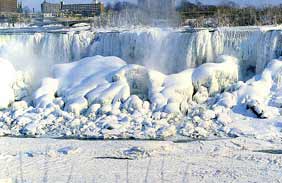2st PART
During harsh winters temperatures can drop
very low as we can see on the map below of lowest records
from 1951 to 1988 for France on left and from 1888 to 2012
for the other side of the Atlantic in USA on right . When in France, minimum temperatures fall
to -4°F (-20°C) and even lower as it was the case
in 1829/1830, 1879/1880, 1955/1956, 1962/1963 or 1984/1985
and more other winters, then a continental climate happens
in France and Eastern Europe. Lakes and rivers freeze over
several centimeters in thickness. In January
1985 the Rhine was frozen to 70 cm thick and even the Garonne
was frozen. Winter 1879/1880 was so cold that Lake Annecy
was completely frozen (which is produced only in 1830 and
1880). With temperatures of
-11°F (-24°C) to -27°F (-33°C) in Paris and
North that winter the Seine was covered with 30 cm of ice
as was the case in February 1895. So people could cross
it with feet. On 02/05/1956 there
were even ices approximately 1 meter by 50 cm on the Loire. The
winter of 1996-1997 in Nantes the Loire was taken by the cold.
Some years there are examples of cases where
the temperatures were so low that ice started or was formed.
This was the case in 1568/1569 in Bordeaux. Winter 1755/1756
and 1775/1776 the mouth of the Seine was frozen for 8 km as
the ice. The boats were trapped by ice.
In USA during the coldest winters, a huge
bridge of ice can form on the Niagara Falls as was the case
in 1910/1911. The water continues to flow beneath the ice
at all times, albeit reduced to a mere trickle on rare occasions
when ice jams block the river above the falls. In March of
1848, so much ice had flown into the the Niagara Falls that
the falls literally stopped moving.
Click here to
see another picture of
WARNING |










